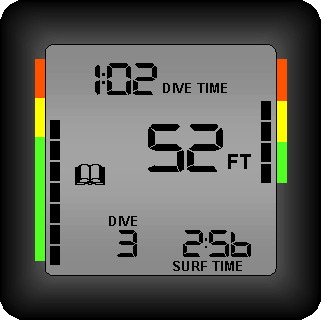Dive Computers
A dive computer is an optional but popular device that serves as an alternative to dive tables. They constantly evaluate your depth, dive time, and nitrogen levels to determine your remaining no-decompression dive time. Some computers even contain digital submersible pressure gauges that can calculate your remaining air time!
This lesson covers the benefits of dive computers, special rules you must follow when using them, and the typical display modes computers use to display information.
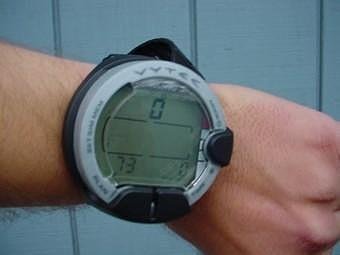
Benefits of Dive Computers
Dive computers have many benefits, which makes up for their increased cost. Following are just a few of these benefits.
- Increased maximum dive time
- When you use tables, your maximum dive time is determined by your maximum depth. This is called a "square profile," and illustrated by the chart to the left. The truth is, most dives do not have a square profile, so your nitrogen ingassing rate changes as you change your depth. Dive computers constantly recalculate your maximum dive time by evaluating your current depth, ingassing rate at that depth, and current nitrogen levels. As a result, your maximum dive time increases when you use computers.
- Elimination of table-related errors
- Dive computers automatically calculate your no-decompression limits for you. This eliminates the risk of user-error that's present when using dive tables.
- Integration of features
- At a minimum, computers contain an integrated depth gauge and bottom timer. Optional features include a thermometer and submersible pressure gauge. This reduces the number of instruments you must carry during a dive.
- Dive profile memory
- Dive computers store critical information about your previous dives so you can access the information when needed. This eliminates the need to document this information during and immediately after a dive, and is especially useful when documenting your dives in a logbook.
- Altitude compensation
- Most dive computers include an altitude compensation feature that adjusts your no-decompression limits when diving at high altitude. This eliminates the need to use special altitude adjustment tables that would otherwise be required to plan the dive.
- Monitoring of nitrogen levels in various tissue compartments
- Your body's various tissues ingas and offgas nitrogen at different rates, and the rate changes with your depth. This means that as you ascend to shallower water, certain tissues may offgas nitrogen while others continue to ingas nitrogen. Computers are able to monitor nitrogen levels in various hypothetical tissue compartments, and base your remaining dive time on the compartment with the highest nitrogen level. This provides more accurate time limits, as well as increased dive time.
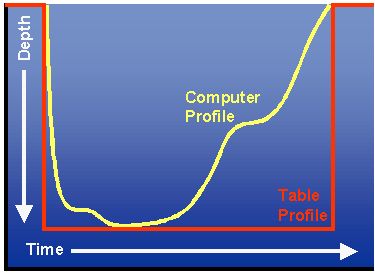
Using Dive Computers
As with tables, there are several rules you must follow when using dive computers. Following these rules helps to ensure their accuracy and your safety.
- Read the computer's manual
- Dive computers vary in their display, operation, and features. For this reason, you should carefully read the computer's manual before using it for the first time.
- Avoid decompression dives
- Computers feature a decompression mode that displays decompression requirements in the event you exceed your maximum dive time. The fact that this feature exists does not equip you with the skills and equipment required for planned decompression dives. You should use this feature only in the event you accidentally exceed your dive limits.
- Each buddy in a team must have a separate computer
- No two divers share the same dive profile, so each diver must have his or her own computer. Additionally, since the remaining dive time indicated by each computer may be different, you should follow the most conservative limit.
- Use your computer on all dives
- You must stay out of the water for at least 24 hours before using a computer for the first time, and that computer must be used on all repetitive dives. This ensures that the nitrogen levels stored in the computer are accurate to your actual levels.
- End your dive if your computer fails
- If your computer fails during a dive, immediately make a safe ascent to the surface. Remain out of the water for 24 hours, and have the computer inspected and repaired before using it again.
- Activate your computer before entering the water
- Forgetting to turn on or activate your computer before descending can result in inaccurate pressure readings. If you discover that you forgot to activate your computer, immediately make a safe ascent to the surface, activate your computer, and resume the dive. Many computers contain water sensors that automatically activate the computer when they become wet. If the computer you use has this feature, it's still a good idea to manually activate the computer before beginning a dive. This helps to ensure the computer operates correctly before beginning the dive.
Display Modes
The information displayed by a computer changes depending on whether you're diving, are at the surface, or have exceeded your maximum dive time. Additionally, there are features you can access while at the surface that enable you to plan your next dive or review your dive history.
The pages that follow illustrate and describe the typical information displayed by the various display modes. Before continuing, it's important to note that the layout and information displayed varies between computers. This information is provided only as an introduction to computers in general, and does not substitute for the computer's user's manual.
Initialization Mode
All computers perform an initialization sequence once activated or turned on. This sequence tests the computer's internal functions and display. While initializing, the computer will display all of its icons and digits. You should observe this display during initialization to ensure that the numbers and alerts will be accurate during the dive.
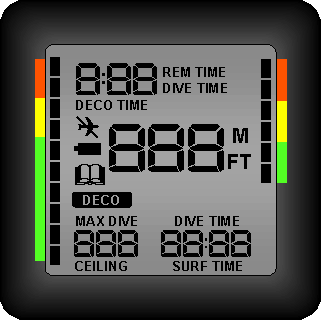
Dive Mode
The dive mode displays critical and up-to-date information about your current dive while you are at depth. This mode is automatically activated as soon as you descend. It's paused when you reach the surface, and after a specific length of surface time, the computer returns to the surface mode.
Typical information displayed during the Dive Mode include:
- Current Depth: Your current depth. This feature serves the purpose of a depth gauge.
- Dive Timer: Displays the length of time you have been underwater.
- Remaining Dive Time: Your remaining dive time, based on your current depth and nitrogen level. This time decreases as you descend, and increases as you ascend.
- Nitrogen Level: Your current nitrogen level, based on the compartment with the highest nitrogen level.
- Maximum Depth: The maximum depth you've reached during the current dive.
- Ascent Rate Indicator: Displays your ascent rate as you ascend towards the surface.
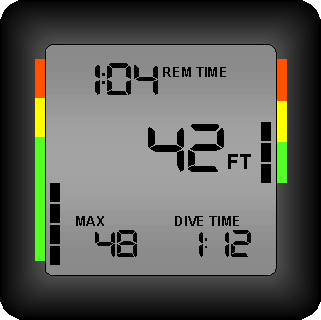
Decompression Mode
If you exceed your maximum dive time, the computer will automatically switch to decompression mode. This mode displays your required decompression stop procedures, as well as an alert or audible alarm to gain your attention.
Typical information displayed during the Decompression Mode include:
- Decompression Mode Indicator: An icon, and usually an audible alarm, that informs you of the decompression requirement.
- Ceiling: The depth you must ascend to for the decompression stop. Do not ascend shallower than this depth.
- Decompression Stop Time: The amount of time you must wait at the indicated ceiling to complete the decompression stop. After completing this stop, the computer might provide another required stop, at a shallower ceiling.
- Ascent Time: The total ascent time required before surfacing, including all planned decompression stops.
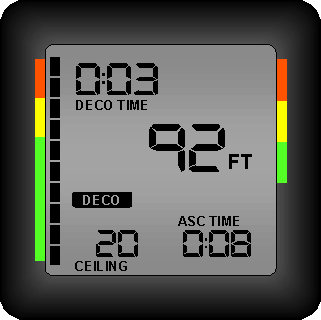
Scrolling Mode
The scrolling mode is used to determine your adjusted maximum dive time for a specific planned depth. In this mode, computers automatically scroll through a list of depths and their associated dive time.
You should always consult with the scrolling mode before starting a dive to ensure that you've offgassed enough nitrogen to safely complete a planned repetitive dive. Computers update this information as you offgas more nitrogen, so if the computer determines that you cannot complete your planned dive, extend your surface interval until you can complete your desired dive profile.
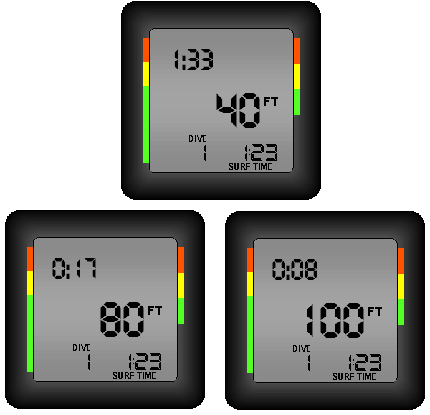
Surface Mode
The surface mode is displayed while at the surface. It provides important information about your previous dive, as well as any alerts that may be applicable.
Typical information displayed during the Surface Mode include:
- Maximum Depth: Your previous dive's maximum depth.
- Surface Interval Time: The elapsed time since surfacing from your previous dive.
- Dive Time: Your previous dive's bottom time.
- Residual Nitrogen Level: A graphical illustration of your current residual nitrogen level. This display updates over time as you remain at the surface and offgas nitrogen.
- Dive Number: The number of dives in a current repetitive dive series. In this example, the diver has just completed the first dive in a repetitive series. After the next dive, this display will change to "2."
- Wait to Fly Indicator: Indicates that you should wait before flying. Most computers also indicate how long you should wait before flying.
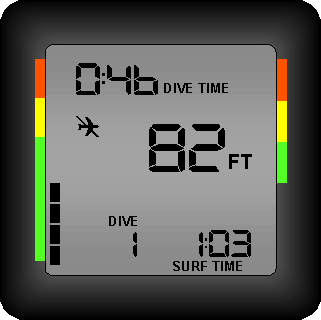
Log Mode
The log mode can be accessed while in surface mode, and is a useful tool for transferring your dive profiles and history to your logbook.
Typical information displayed during the Log Mode include:
- Log Mode Indicator: An icon or text label that indicates you are in log mode.
- Dive Number: The displayed dive's number. Computers vary in how they determine a dive's number, so consult your specific computer's manual to see how it determines the dive number.
- Maximum Depth: The displayed dive's maximum depth. Some computers also display your average depth.
- Bottom Time: The actual dive time for the displayed dive.
- Surface Interval Time: The length of the surface interval that preceded the dive.
- Maximum Ascent Rate: The displayed dive's maximum rate of ascent.
- Final Nitrogen Level: The level of nitrogen in your body when you surfaced from the dive.
